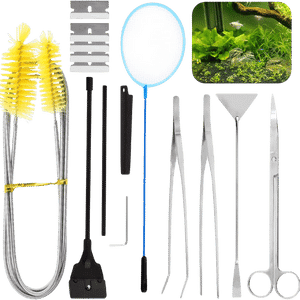Java Moss for Betta Fish, Is It Good?
Hello, aquatic enthusiasts! Welcome to our blog post about Java moss for Betta fish.
If you’ve been scratching your head, wondering what plant would make a fabulous addition to your betta fish tank, you’re in for a treat.
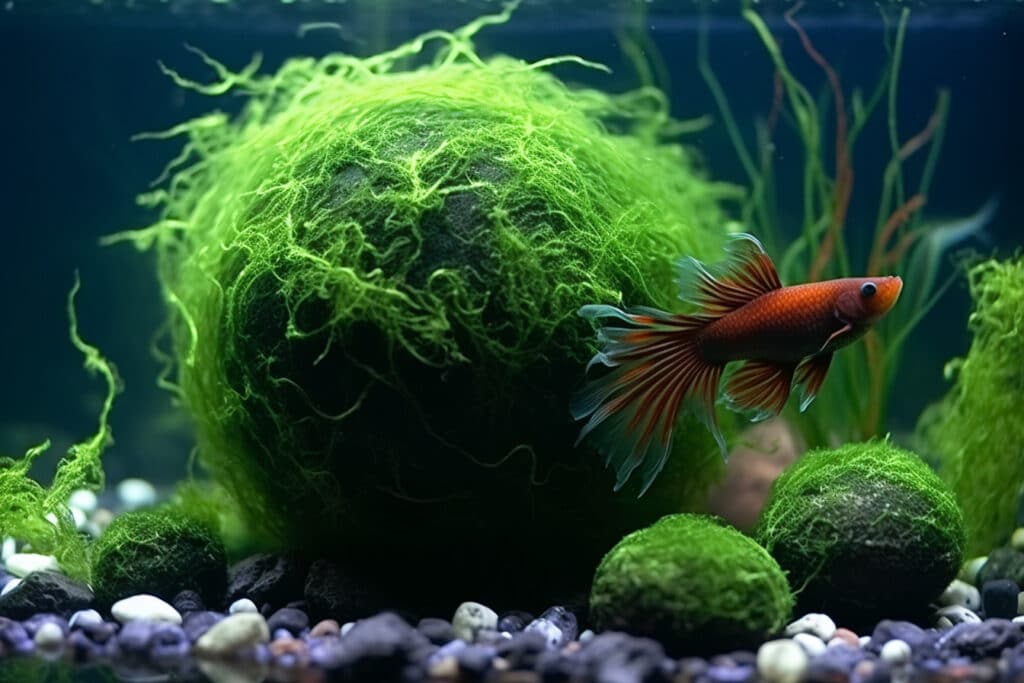
Let’s talk about Java Moss, One of the most popular aquarium plants and and easy to care aquarium moss, a low-maintenance, hardy, and utterly beautiful plant that betta fish seem to adore.
Why is Java Moss the talk of the town (or should we say, tank)? Well, this remarkable aquatic plant not only enriches your aquarium’s looks but also creates a healthier environment for your betta fish.
In this comprehensive post, we’ll dive deep into the world of Java Moss.
From its unique features and benefits to detailed care guidelines, we’ve got it all covered. We’ll also compare it to other popular aquatic plants and tackle some of the most frequently asked questions.
So whether you’re a betta fish rookie or a seasoned tank owner, stick around to discover why Java Moss should be on your aquarium plant shopping list.
Table of Contents 🦑
A Quick Heads-Up… If you come across links on this page that take you to products on Amazon Associate or other partner stores, they’re affiliate links. This means if you decide to make a purchase, BettaReef earns a commission, but at no extra cost to you.

Benefits of Java Moss
So, you’re intrigued about Java Moss, and rightfully so! This fantastic aquatic plant comes packed with features and benefits that will leave both you and your betta fish grinning. Let’s take a closer look at why Java Moss is a top contender for the best betta-friendly plant.
Easy to Grow Java Moss
The first thing you’ll love about Java Moss is its hardiness. It’s virtually indestructible and can tolerate a wide range of water conditions. Whether you’re a seasoned aquarist or a complete newbie, you won’t have a tough time keeping this plant alive and thriving.
Another aspect to consider with Java Moss is its rapid growth rate, which can swiftly fill your aquarium with vibrant green foliage, given the appropriate conditions. Regular trimming is essential to manage its growth effectively. To dive deeper into How fast java moss grows, explore the insights provided in this article.
Versatile Looks
Java Moss offers a stunning green backdrop that can liven up any aquarium. Whether you want Java moss carpet on the bottom, make a Java moss wall, or drape it over some rocks, this plant provides versatility in aquascaping that is hard to beat.
Natural Playground
Your betta will appreciate the intricate network of tiny leaves and stems. It’s an ideal playground that provides hiding spots and even aids in spawning. The moss is dense enough to offer privacy but not too thick to obstruct swimming paths.
Improves Water Quality
Java Moss absorbs excess nutrients like nitrites and ammonia from fish waste in the water. By doing so, it contributes to maintaining a healthier, cleaner environment for your betta fish.
Low Light, No Problem
Unlike some aquatic plants that demand a specific light level, Java Moss can thrive even in low light conditions. This is especially helpful for betta tanks that may not have high-intensity lighting.
Natural Food Source
Tiny microorganisms that provide additional food for your betta often grow on Java Moss, making it not just a plant but a functional part of your aquarium’s ecosystem.
Now that you know why Java Moss is the bee’s knees when it comes to aquatic plants for betta fish, wouldn’t you agree it’s almost like it was custom-made for your finned friend? Stay tuned as we delve into how to care for this exceptional plant and make it a permanent resident in your betta’s underwater kingdom!

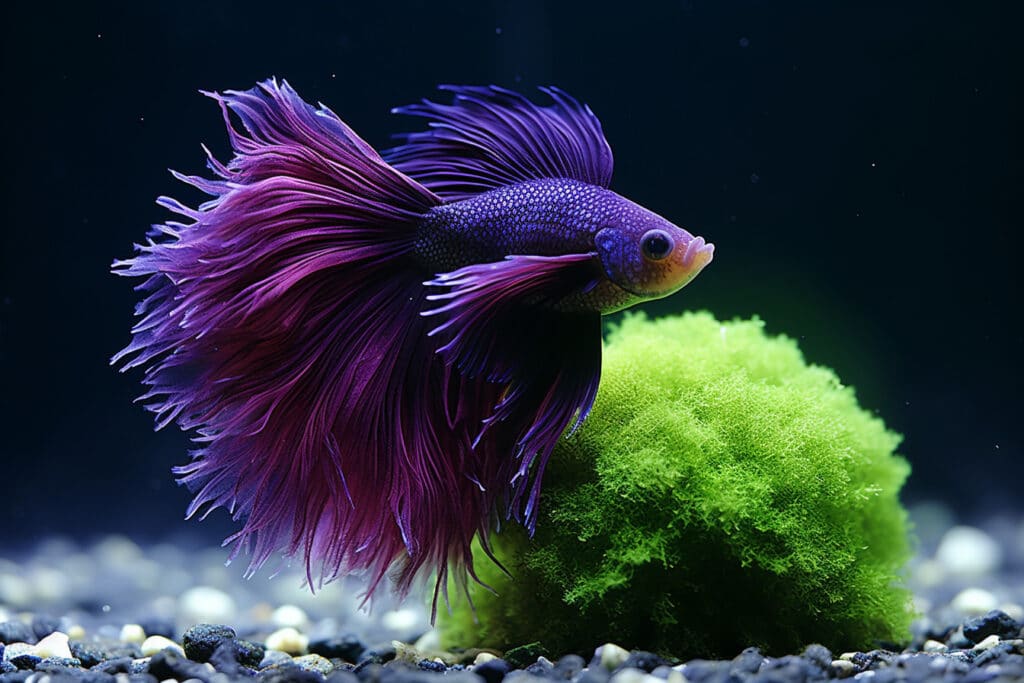
The Natural Habitat of Betta Fish: Where Does Java Moss Fit In?
Ah, the mysterious and captivating world of betta fish! Originating from the shallow, slow-moving waters of Southeast Asia, betta fish are accustomed to a habitat filled with an array of aquatic plants and hidden nooks.
Picture lush, green vegetation where these colorful fish can dart in and out, playing hide-and-seek while also taking short rest breaks. It’s like a cozy, underwater home!
Now, here’s where Java Moss swaggers in, offering a pinch of that natural paradise to your home aquarium.
Just like the aquatic foliage that bettas love in their native environment, Java Moss provides that safe haven for them, in nature, Java moss grows as well in Southeast Asia, usually on rocks and tree trunks, So it’s like giving your betta a slice of its ancestral home, complete with all the comforts it offers.
So, not only does it spruce up your tank visually, but it also fulfills your betta’s innate love for intricate, plant-filled spaces. Talk about a win-win!
Why Java Moss is a Betta's Best Friend
If you’re still on the fence about adding Java Moss to your betta tank, this section is the final nudge you need. This unassuming green Java moss carpet is actually a multi-talented superstar that can drastically improve the life of your betta. Let’s dive into the specifics!
Hiding Spots
Java Moss creates a textured, forest-like environment within your tank, offering your betta numerous nooks and crannies to explore and hide in. This is especially important for bettas, who are territorial and enjoy having their own secluded spots.
Improves Water Quality
Java Moss helps in absorbing excess nutrients like nitrate and phosphate from the water, making it cleaner and healthier for your betta. Plus, the plant also provides oxygenation, aiding in maintaining a balanced aquatic environment.
Stress Reduction
A tank that resembles a betta’s natural habitat can significantly reduce stress in these little swimmers. A less-stressed betta is a healthier, more active, and more vibrant betta.
Natural Food Source
While not a primary food for bettas, the moss attracts microorganisms that your betta can snack on. It’s like a natural buffet!
Aesthetic Appeal
This goes for both you and your betta. The lush green provides a stunning contrast to your betta’s vivid colors, making for a truly Instagrammable tank.
Easier Breeding
If you’re interested in breeding bettas, Java Moss provides an excellent medium for the eggs to attach to, increasing their chances of survival.
So, there you have it. With so many benefits, it’s clear why Java Moss is a prime choice for any betta fish tank. It’s like gifting your betta a combination of a playground, health spa, and fine dining experience, all rolled into one!
Comparing Ideal Water Parameters for Java Moss and Betta Fish
It’s essential to have a balanced aquatic environment, especially when you are dealing with both plant life and fish in the same tank.
Knowing the ideal water parameters for both your Java Moss and your betta fish can help you create an ecosystem where both can thrive. Below is a table that compares the optimal conditions for both, helping you make informed decisions on water maintenance.
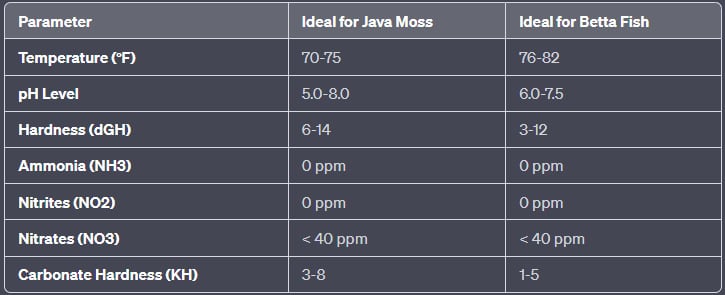
Note: All values are approximate and may vary based on specific conditions. Always monitor your tank and adjust as necessary for the health of your aquatic life.
How to Introduce Java Moss into Your Betta Kingdom: A Step-by-Step Guide
So you’re ready to jazz up your betta’s underwater palace with some Java Moss? Great choice! Here’s a straightforward, step-by-step guide to ensure a seamless transition from “just a tank” to “Java Moss Haven.”
Preparation is Key: Before anything else, give your Java Moss a good rinse under cold tap water. This helps remove any potential contaminants.
Anchor Away: Decide how you want to anchor the moss. You can tie it to driftwood, rocks, or any other ornament with a fishing line or thread, or simply let it float.
Tank Placement: Find the ideal spot in your tank. Java Moss doesn’t require a lot of light, so you have a bit of flexibility here. Just make sure it’s a place where your betta will enjoy swimming through.
Securing the Moss: If you’re anchoring it, securely tie the moss to your chosen anchor. Make it tight enough to hold, but not so tight that it cuts into the plant. Cut off any excess fishing line or thread.
Water Conditions: Before introducing the moss, ensure the water temperature is suitable for both the betta and the moss. Java Moss thrives at temperatures between 59-86°F, which happily coincides with betta-friendly temperatures.
Planting Time: Gently place the anchored or free-floating Java Moss into the tank. If floating, it will eventually attach itself to something. If anchored, make sure it’s secure.
Keep an Eye on It: For the first few weeks, keep an eye on the moss and your betta to ensure they are getting along and that the java moss attached itself as expected. You may need to trim the moss if it starts to grow too much.
Celebrate: Give yourself a pat on the back. You’ve just made a significant upgrade to your betta’s living space!
With these steps, you’ll set the stage for both a happier betta and a more vibrant, natural-looking aquarium. Cheers to your betta’s new leafy playground!

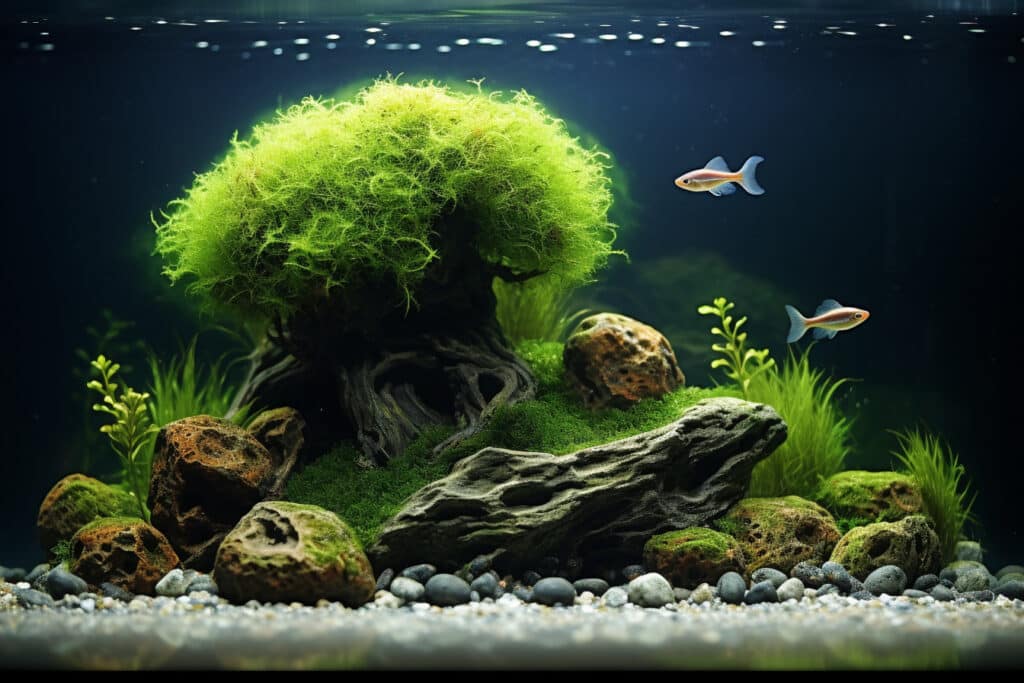
The Ultimate Care Guide for Java Moss in Your Betta Tank
Okay, you’ve introduced this lush green wonder to your tank, so what next? How do you make sure it thrives as much as your betta? Don’t worry, Java Moss is one of the most low-maintenance plants out there, but a little extra love never hurt, right? Here are your care guidelines:
Light
Java Moss isn’t very fussy about light, which is one reason it’s perfect for betta tanks. Low to moderate lighting works best. If you have a more brightly lit tank, the moss will grow faster, but it might also promote algae growth. Balance is key!
Water Conditions
This moss is remarkably resilient. It can tolerate a range of water conditions, but ideally, aim for a pH between 5 and 8 and temperatures from 59-86°F. Since these are conditions that bettas also enjoy, it’s a win-win!
Filtration
A gentle or moderate water flow is ideal. Too strong a current may prevent the moss from attaching to surfaces and growing properly.
Pruning
Java Moss can grow quite luxuriantly if it finds the conditions to its liking. That’s great, but sometimes it can go overboard. Trim it back if it starts to take over your tank or if you notice some sections beginning to brown.
Fertilization
While Java Moss will generally grow fine without added nutrients, you can boost its growth with a basic aquarium plant fertilizer. Just make sure it’s betta-safe!
Algae Control
Since Java Moss grows in low-light conditions, it doesn’t typically attract a lot of algae. However, if you find that algae are starting to become roommates with your moss, consider adding a few algae-eating shrimp to your tank, which is also betta-friendly.
Frequent Checks
Do regular checks for rotting or browning sections and remove them. This keeps the plant healthy and ensures it continues to provide a stimulating environment for your betta.
Armed with these care tips, your Java Moss should provide a lush, green backdrop for your betta’s underwater escapades for years to come. Happy fishkeeping!

5 Must Tools and Accessories for Java Moss Care
So, you’ve decided that Java Moss is the perfect green addition to your betta fish’s aquatic palace. Great choice! Now let’s talk about the tools and accessories that can elevate your mossy endeavor from “just okay” to “absolutely splendid.”
Aquarium Plants Scissors: These are essential for trimming and shaping the Java Moss as it grows. Proper trimming ensures that the moss doesn’t overgrow and suffocate other plants or become a hindrance in the tank.
Aquarium Plants Tweezers: These are helpful for planting the Java Moss initially and for making fine adjustments to its placement later on.
Water Conditioner: Before introducing Java Moss to your betta tank, you’ll need to prepare the water with a suitable conditioner to remove chlorine and other harmful substances.
Quality Substrate: You can grow java Moss without substrate, but having a layer of quality substrate can offer a more natural look and can help other plants in the tank thrive.
Suction Cups or Fishing Line: To anchor the Java Moss to rocks, driftwood, or other surfaces in the tank, you’ll need suction cups or a fishing line. This ensures that the moss stays where you want it to.
By investing in these tools and accessories, you’re not just creating an environment where Java Moss can survive—you’re setting the stage for it to thrive. And let’s be real, the better your Java Moss looks, the happier your betta fish will be!

This 13-piece set, crafted from high-quality stainless steel, is perfect for aquascaping, providing everything you need to create a beautifully designed aquatic environment.

Common Issues with Java Moss and Their Fixes
As versatile and low-maintenance as Java Moss is, it isn’t entirely free from potential issues. But fear not! Most of these challenges are easily addressed with a little know-how. Here are some common problems and how to troubleshoot them:
Algae Growth
Algae can sometimes take advantage of the nutrient-rich environment created by Java Moss.
Solution: Reduce the lighting duration and consider adding algae-eating critters like snails or shrimp. Regular trimming can also prevent algae from choking your moss.
Browning or Yellowing
Sometimes, Java Moss may lose its vibrant green hue, indicating potential problems.
Solution: Check your water parameters, including pH, temperature, and nutrient levels. Adjust accordingly and consider using liquid fertilizers designed for aquatic plants.
Poor Growth
Java Moss is usually a fast grower, but sometimes it might lag.
Solution: Again, this could be due to imbalanced water parameters or inadequate lighting. Ensure that your tank conditions are optimal for moss growth.
Detachment
Newly installed Java Moss may sometimes float away or detach from the surface it’s supposed to adhere to.
Solution: Use a fishing line or cotton thread to secure it initially until the java moss attaches itself naturally.
Invasion of Microorganisms
While Java Moss attracts beneficial microorganisms, sometimes unwanted guests like detritus worms can make an appearance.
Solution: Regular maintenance, including gravel vacuuming and water changes, can help keep these critters at bay.
With these tips in your plant-care arsenal, you’ll be well-equipped to tackle any Java Moss-related issues that come your way. A well-tended moss means a happier, healthier betta fish!

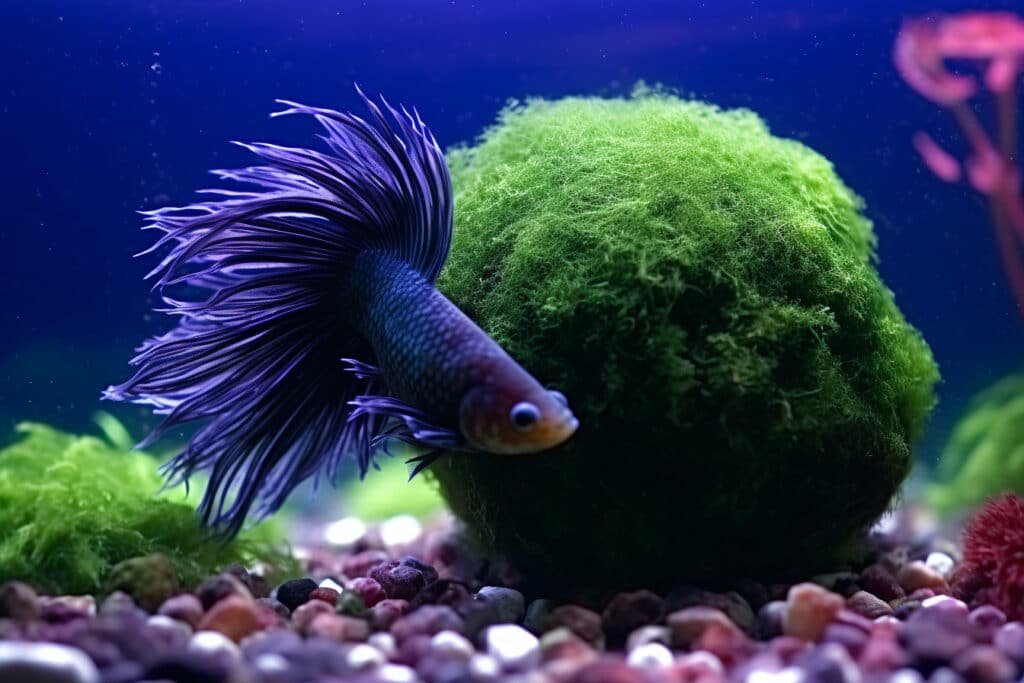
Common Mistakes to Avoid When Incorporating Java Moss
Java Moss plant is generally easy to care for, but there are some common pitfalls that even seasoned aquarists can fall into. Knowing what to avoid can save you time, effort, and even the health of your betta fish.
Overcrowding the Tank: Java plants grow quickly and can easily take over your tank if not properly managed. Make sure you’re mindful of how much moss you add initially and keep it trimmed to avoid suffocating other plants or animals.
Ignoring Water Conditions: While the Java plant is hardy, it still requires specific water conditions to thrive. Neglecting water quality can result in unhealthy moss and could even harm your betta fish.
Incorrect Planting: Believe it or not, there is a wrong way to plant Java . Failing to secure it properly can result in the moss floating around and potentially clogging your filtration system.
Lack of Regular Maintenance: The Moss plant requires regular trimming to stay healthy. Neglecting this task can result in the moss overgrowing and affecting the water quality, as well as the health of other plants and fish in the tank.
Using Untreated Tap Water: Always use conditioned water when introducing new moss or performing water changes. Untreated water can contain chlorine, which can harm both the moss and your fish.
By being aware of these common mistakes and taking the necessary precautions, you’ll be well on your way to creating a healthy, beautiful environment for your betta fish with the help of Moss.

Safety Tips: Sourcing Java Moss plants
Java Moss is a wonderful addition to any betta fish tank, but like all live plants, it can come with unwanted pests or diseases. Here are some precautionary steps to take to ensure you’re introducing healthy, safe moss into your aquatic haven:
Buy from Reputable Sources: Always purchase Java Moss from well-reviewed, reputable suppliers. Trusted aquatic plant stores are less likely to sell plants that carry diseases or pests.
Inspect Before You Buy: Before making a purchase, take a close look at the Java Moss plant. Healthy moss should have a vibrant green color. Avoid moss that looks discolored, brown, or has a slimy texture, as these can be signs of poor health or contamination.
Quarantine New Plants: Before introducing Java Moss into your main tank, keep it in a quarantine tank for at least one to two weeks. This will give you time to observe the plant for any signs of pests or diseases.
Disinfect the Moss: You can opt to disinfect the Java Moss plant by giving it a bleach dip. Mix 19 parts water with 1 part bleach and dip the moss in this solution for not more than 2 minutes. Rinse thoroughly with conditioned water before planting.
Rinse Thoroughly: Regardless of whether you choose to bleach-dip your Java Moss, always rinse it under conditioned water to remove any debris or potential parasites.
Check Compatibility: Ensure that any chemicals or treatments you’re using in your tank are safe for plants. Some medications for fish are harmful to plants, and you don’t want to introduce Java Moss only for it to suffer from chemical exposure.
Consult Community and Forums: Before making a purchase, it’s also a good idea to seek advice from other aquarium enthusiasts. Forums and online communities can be good platforms to get reviews and recommendations on where to source healthy Java Moss.
By taking these safety precautions, you can greatly reduce the risk of introducing pests or diseases that could affect your betta fish or other aquatic life. Remember, a healthy plant means a healthy tank!

Java Moss Propagation, An Easy Venture!
If you’re enchanted by the myriad benefits of aquarium Java Moss, you’ll be thrilled to know that propagating this green gem is a breeze.
The Java Moss scientific name, Taxiphyllum barbieri, may sound complicated, but propagating it certainly isn’t. All you need to do is snip off a section and place it where you’d like it to grow in your aquarium.
Given the right conditions, this section will latch onto surfaces and expand, adding more greenery to your betta’s underwater kingdom.
So, if you’re keen on enhancing multiple tanks or sharing the joy with friends, Java Moss propagation has got you covered!
Java Moss Vs. Other Popular Plants 🌱🥊
Java Moss has earned its rightful place in the aquascaping world, especially when it comes to betta tanks. But how does it stack up against other popular plants that betta owners often consider? Let’s dig into a comparison to find out!
Java Moss Vs. Anubias
Anubias: Known for its broad, dark-green leaves and easy care requirements.
Ease of Care: Similar to Java Moss, low maintenance.
Benefits for Betta: Offers hiding spaces but is less intricate than moss.
Winner: Java Moss, for its superior hiding spaces and spawning grounds.
Java Moss Vs. Amazon Sword
Amazon Sword: Another easy-to-care-for plant, with long, broad leaves.
Ease of Care: Moderate; requires more light and nutrients.
Benefits for Betta: Provides broad leaves for rest but no small hiding spots.
Winner: Java Moss, for its low-maintenance care and multi-purpose use.
Java Moss Vs. Duckweed
Duckweed: A floating plant that bettas sometimes enjoy pushing around.
Ease of Care: Very easy but can overpopulate the tank.
Benefits for Betta: Provides shade and surface cover, but no hiding spaces below.
Winner: Java Moss, for its all-around habitat enrichment.
Java Moss Vs. Water Wisteria
Water Wisteria: Known for its delicate, feather-like leaves and stems.
Ease of Care: Moderate; requires proper lighting and nutrients.
Benefits for Betta: Excellent hiding spaces but needs more care.
Winner: Java Moss, due to its lower care requirements and similar benefits for bettas.
Java Moss Vs. Christmas Moss
Christmas Moss: Similar to Java Moss but not as forgiving in varying conditions.
Ease of Care: Moderate; Christmas Moss is more sensitive to water conditions and generally prefers cooler, well-circulated, and clean water.
Benefits for Betta: Provides hiding spots and improves water quality, similar to Java Moss. However, it’s less forgiving in varying conditions, making it a bit less ideal for bettas.
Winner: When it comes to ease of care and benefits for betta fish, Java Moss takes the title. Its adaptability and resilience make it a more beginner-friendly option, without sacrificing any benefits for your betta fish.
In each of these categories, Java Moss tends to come out on top because of its easy care and multi-functional nature. Whether you’re a newbie or an experienced aquarist, Java Moss offers an all-in-one package that’s hard to beat.

FAQs: Your Burning Questions About Java Moss and Betta Tanks, Answered!
Q: Is Java Moss safe for betta fish?
A: Absolutely! Java Moss is one of the most betta-friendly plants you can introduce into a tank. It provides hiding spots, enriches the water, and is non-toxic.
Q: Does Java Moss require special lighting?
A: Not really. Java Moss is quite forgiving when it comes to lighting conditions, although moderate lighting will help it grow more robustly.
Q: Can Java Moss help improve water quality?
A: Yes, Java Moss can absorb some of the nitrates and other nutrients, improving the overall water quality of your betta tank.
Q: How fast does Java Moss grow?
A: The growth rate of Java Moss largely depends on the conditions you provide. With optimal lighting and water conditions, you can expect it to grow faster.
Q: Will my betta eat the Java Moss?
A: It’s unlikely. Betta fish are carnivorous by nature and usually show little interest in plants. However, the moss may harbor tiny organisms that your betta might enjoy hunting.
Q: Can I use Java Moss in a saltwater tank?
A: Java Moss is best suited for freshwater tanks and is not recommended for saltwater environments.
Q: Does Java Moss need a substrate?
A: No, Java Moss can easily attach itself to various surfaces, Or you can stick Java moss to rocks, driftwood, or even tank glass, so a substrate is not necessary for its growth.
Q: How do I trim and maintain Java Moss?
A: Trimming Java moss is easy—just use aquarium-safe scissors to cut back excessive growth. Regular trimming will also keep a healthy java moss alive
Now that we’ve addressed some of the most common questions, you’re well-equipped to make your betta tank a leafy paradise with the amazing Java Moss!

Conclusion: Why Your Betta Will Thank You for Choosing Java Moss
Java Moss isn’t just a plant, it’s a mini ecosystem in its own right, a versatile green powerhouse that brings multiple benefits to your betta fish tank.
From providing the perfect hideaway spots to maintaining better water quality, it’s the all-in-one package for any betta owner.
Whether you’re a first-timer or a seasoned aquarium enthusiast, Java Moss offers an easy-care, aesthetically pleasing, and functionally rich option for enriching your underwater world.
So, why not take the plunge? Your betta will surely thank you for it, possibly with a few happy bubbles!
A Big Thank You!
Thank you for diving deep with us into the lush world of Java Moss and betta fish! We hope this guide has not only answered your questions but also inspired you to explore the transformative power of this simple yet extraordinary aquatic plant. If you’ve found value in this post, we encourage you to share your own Java Moss journeys, insights, or questions in the comments below.
Your participation makes our community richer and helps fellow betta enthusiasts thrive. Happy fishkeeping! 🐟🌱

Delighted to have you here at BettaReef! This place is a treasure trove of knowledge about Betta fish, Betta Care, Health, Gear, and much more from the wonders of aquatic life. My journey in this fascinating world began when I was just 8, and now, as a seasoned hobbyist, I’m here to help fellow Betta enthusiasts create a thriving Betta environment for a healthy life.
I’m committed to delivering high-quality content, backed by a stringent editorial process. Each product review is based on real-life usage and practical analysis, ensuring that you get insights and advice that truly matter.
Related Blog Posts:
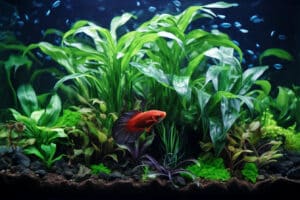
Best Anubias Plants For Betta Fish
Best Anubias Plants For Betta Fish Today, we’re diving deep into the world of Anubias
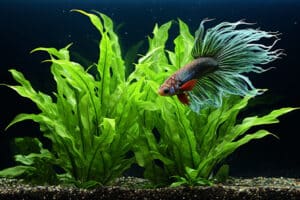
Java Fern The Green Oasis in Your Betta Fish Tank
Java Fern The Green Oasis in Your Betta Fish Tank Welcome to the green side
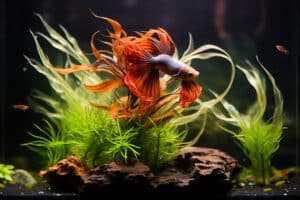
The Best Aquatic Plants For Betta Fish
Home The Best Aquatic Plants For Betta Fish Aquatic Plants for Betta Fish: Uncover the

